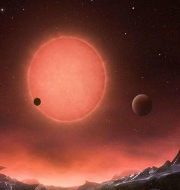Scientists discover 100 new exoplanets using K2 mission data
Scientists have confirmed discovery of nearly 100 new exoplanets outside our solar system based on data from second mission of NASA’s Kepler Space Telescope (K2 mission) released in 2014. With this total number of exoplanets found using NASA’s K2 mission has reached almost 300.
Key Facts
The discovery had started out by analysing 275 candidates of which 149 were validated as real exoplanets. In turn, 95 of these planets have proved to be new discoveries. One of planets detected was orbiting a very bright star called HD 212657 with 10-day orbit period. HD 212657, is now the brightest star found by either the Kepler or K2 missions to host validated planet.
Significance
Exoplanets are very exciting field of space science. This discovery will help astronomers to develop much better picture of nature of exoplanets which in turn will allow us to place our own solar system into galactic context. Discovery of planets around bright stars will help astronomers to learn about them from ground-based observatories.
Kepler Mission
NASA had launched Kepler spacecraft in 2009 to hunt for exoplanets in single patch of sky. The spacecraft had crippled the telescope in 2013 due to mechanical failure. However, by changing its field of view periodically, astronomers and engineers had then devised way to repurpose and save the space telescope which had paved way for K2 mission. The telescope hunts exoplanet transits by registering dips in light caused by shadow after it crosses in front of its host star.
Exoplanet
It is a planet that does not orbit Sun and instead orbits different star, stellar remnant, or brown dwarf. It is also termed as extrasolar planet. The first such planet orbiting star similar to our own Sun was detected only in 1995. Today some 3,600 exoplanets have been found, ranging from rocky Earth-sized planets to large gas giants like Jupiter.
Month: Current Affairs - February, 2018


